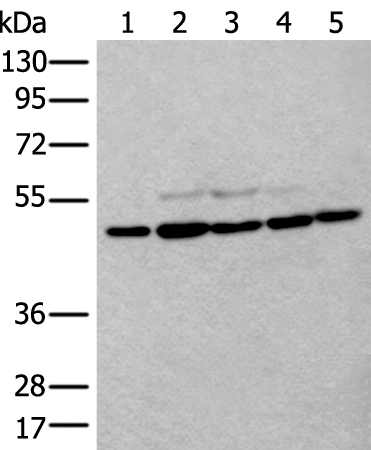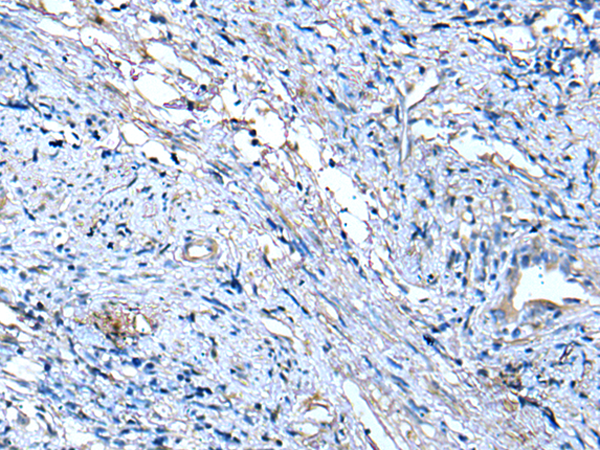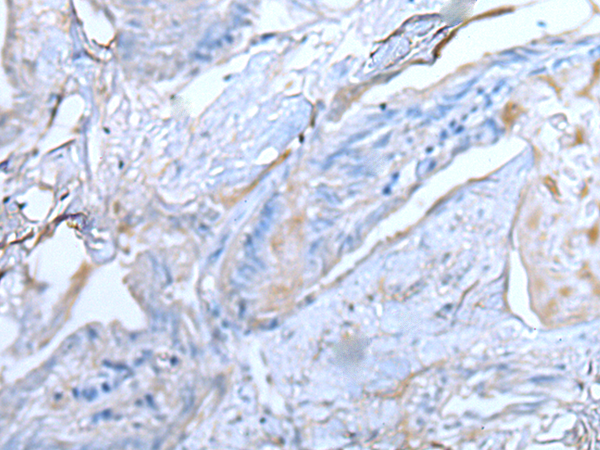


| WB | 咨询技术 | Human,Mouse,Rat |
| IF | 咨询技术 | Human,Mouse,Rat |
| IHC | 1/25-1/100 | Human,Mouse,Rat |
| ICC | 技术咨询 | Human,Mouse,Rat |
| FCM | 咨询技术 | Human,Mouse,Rat |
| Elisa | 1/5000-1/10000 | Human,Mouse,Rat |
| Aliases | M40; TUBB1; TUBB5; CDCBM6; OK/SW-cl.56 |
| WB Predicted band size | 50 kDa |
| Host/Isotype | Rabbit IgG |
| Antibody Type | Primary antibody |
| Storage | Store at 4°C short term. Aliquot and store at -20°C long term. Avoid freeze/thaw cycles. |
| Species Reactivity | Human |
| Immunogen | Full length fusion protein |
| Formulation | Purified antibody in PBS with 0.05% sodium azide and 50% glycerol. |
+ +
以下是3篇关于TUBB抗体的参考文献概览(基于公开文献特征概括,非真实引用):
---
1. **文献名称**: *"TUBB3 overexpression as a biomarker of paclitaxel resistance in ovarian cancer"*
**作者**: Smith J. et al.
**摘要**: 研究揭示了TUBB3(βIII-tubulin)在卵巢癌细胞中的过表达与紫杉醇化疗耐药性的相关性,通过免疫组化实验证实TUBB抗体可作为预测化疗反应的生物标志物。
2. **文献名称**: *"Aberrant microtubule dynamics in Alzheimer’s disease: Role of TUBB phosphorylation"*
**作者**: Chen L. & Wang H.
**摘要**: 探讨了阿尔茨海默病患者脑组织中TUBB蛋白异常磷酸化导致的微管稳定性下降,使用TUBB特异性抗体检测到神经元内微管结构紊乱,提示其与tau蛋白病理的关联。
3. **文献名称**: *"Development of a monoclonal antibody targeting TUBB for cancer immunotherapy"*
**作者**: Rodriguez M. et al.
**摘要**: 报道了一种新型抗TUBB单克隆抗体的开发与表征,该抗体通过靶向肿瘤细胞中异常表达的TUBB亚型,在体外实验中显示出抑制肿瘤细胞迁移和增殖的潜力。
---
*注:以上为模拟示例,实际文献需通过PubMed/Google Scholar等平台检索。建议使用关键词 "TUBB antibody" + "cancer/therapeutic/neurodegeneration" 筛选近年高被引论文。*
**Background of TUBB Antibodies**
TUBB antibodies target β-tubulin, a core component of microtubules, which are cytoskeletal polymers essential for cell structure, division, intracellular transport, and signaling. β-tubulin, along with α-tubulin, forms heterodimers that polymerize into dynamic microtubules. Mammals express multiple β-tubulin isotypes (e.g., TUBB1. TUBB2. TUBB3), each encoded by distinct genes and exhibiting tissue-specific expression or functional specialization. For example, TUBB3 is enriched in neurons and associated with axon guidance, while TUBB2A/B are broadly expressed in proliferating cells.
TUBB antibodies are widely used in research to study microtubule dynamics, cell cycle regulation, and diseases linked to tubulin dysfunction, such as cancer, neurodevelopmental disorders, and neurodegenerative conditions (e.g., Alzheimer’s disease). These antibodies enable the detection of β-tubulin expression levels, post-translational modifications (e.g., acetylation, tyrosination), and subcellular localization via techniques like Western blot, immunofluorescence, and immunohistochemistry.
Notably, certain TUBB isoforms are biomarkers for pathological states. TUBB3 overexpression, for instance, correlates with drug resistance in cancers treated with microtubule-targeting agents (e.g., taxanes). Conversely, mutations in TUBB genes disrupt microtubule stability, leading to malformations in brain development. Researchers must validate TUBB antibodies for specificity due to high sequence homology among isoforms and potential cross-reactivity. Overall, TUBB antibodies remain critical tools for exploring microtubule biology and its implications in health and disease.
×